Designing Gamified Virtual Reality Intervention Based on Experiential Learning to Enhance Social Reciprocity in Children with Autism Spectrum Disorder
Abstract
1. Introduction
2. Related Works
2.1. ASD and Social Challenges
2.2. VR Interventions for ASD
2.3. Gamification and Engagement in ASD Training
2.4. Experiential Learning Theory in Immersive Training
2.5. VR Platforms for Intervention
3. Virtual Reality System Design
3.1. Learning Scenario Design
3.2. Gamification and Feedback Features
3.3. Interface and Usability Considerations
3.4. Theoretical Framework
4. Research Design
4.1. Participants
4.2. Instruments
4.2.1. Social Responsiveness Scale
4.2.2. Semi-Structured Interviews
4.2.3. Procedure
4.2.4. Data Analysis
5. Result
5.1. Quantitative Findings from the Social Responsiveness Scale
5.1.1. Pre- and Post-Test Comparisons
5.1.2. ANCOVA Between the Intervention and Control Groups
5.2. Qualitative Findings from Semi-Structured Interviews
5.2.1. Effectiveness of Training Social Reciprocity Skills
5.2.2. Feedback on Content Design
5.2.3. Feedback on VR Design
5.2.4. Acceptance and Sustainability
6. Discussion
6.1. Social Reciprocity and Affective Expression
6.2. Content Relevance and Cultural Adaptation
6.3. Usability, Technical Challenges, and Sustainability
6.4. Limitations and Future Work
7. Conclusions
Author Contributions
Funding
Institutional Review Board Statement
Informed Consent Statement
Data Availability Statement
Conflicts of Interest
Abbreviations
| ASD | Autism Spectrum Disorder |
| SDT | Self-Determination Theory |
| VR | Virtual Reality |
| VR-SS | Virtual Reality Surgery Simulator |
Appendix A
Semi-Structured Interview Questionnaire
- Did the child show any improvement in social interaction or emotional expression after using the VR program? If yes, could you please describe?
- What are your thoughts on the design and relevance of the social scenarios used in the VR system?
- How would you describe the child’s experience using the VR system in terms of usability, sensory response, and engagement?
- Do you think this VR system could be used effectively over the long term in your daily routines or educational settings?
Appendix B
Summary of Qualitative Results
| Theme | Description | Participant ID |
|---|---|---|
| Effectiveness of Training Social Reciprocity Skills | After the sessions, my son started saying hello to our neighbors without being prompted. | C2 |
| He used to avoid eye contact, but now he can respond when someone talks to him, especially in class. | T3 | |
| The child responded well, especially when greeting the teacher. | C1, C4, C5 | |
| At school, she’s better at following turn-taking, but at home, she still struggles to apply what she learned | C6 | |
| VR is a promising tool to introduce social concepts in a controlled, repeatable way | T1 | |
| It can’t replace live interaction or real-world practice | T2 | |
| Feedback on VR Design | My daughter usually loses interest quickly, but she stayed focused during the entire VR session. | C1 |
| The transitions and instructions were easy to follow, and even kids with minimal tech experience could handle it. | T3 | |
| One of the busier scenes with loud background sounds made him anxious. | C5 | |
| The visuals were too fast in one game—it overwhelmed my son and made him take off the headset. | C3 | |
| The headset was a bit too big and kept sliding down during the session. | T1, T2, T3 | |
| Feedback on Content Design | The scenarios were really helpful, especially the ones about taking turns in class | T1 |
| It helped him understand what to say when someone give something or when he needs to wait his turn. | C4 | |
| There need to be more types of activities—the current ones feel too limited,” commented a caregiver | C3 | |
| The content is a bit too rigid; some scenes need to adapt more naturally to different reactions or situations. | C1, C2, C5 | |
| Some of the gestures and settings didn’t quite reflect Thai culture | T2 | |
| Using examples like wai greetings or school lunch routines would make it more relatable | C8 | |
| Acceptance and Sustainability | He asked to play the VR game again the next day. That’s rare for him | C7 |
| The kids didn’t feel like they were doing a therapy session—it felt more like a fun activity, which made them more engaged. | T3 | |
| If we could use this once or twice a week, I think it would really help in the long run, | T2 | |
| There aren’t enough tasks to keep using it long-term—it might get repetitive | C1, C2, C8 | |
| We had to rotate children in and out of a small room to run the session. It’s not easy when space is limited. | T1 | |
| If more levels or goals were added, it would help keep the kids motivated | C5 |
References
- Altın, Y., Boşnak, Ö., & Turhan, C. (2025). Examining virtual reality interventions for social skills in children with autism spectrum disorder: A systematic review. Journal of Autism and Developmental Disorders, 55(9), 1–24. [Google Scholar] [CrossRef] [PubMed]
- American Psychiatric Association. (2013). Diagnostic and statistical manual of mental disorders (5th ed.). American Psychiatric Publishing. [Google Scholar] [CrossRef]
- Baron-Cohen, S., Wheelwright, S., Hill, J., Raste, Y., & Plumb, I. (2001). The “reading the mind in the eyes” test revised version: A study with normal adults, and adults with Asperger syndrome or high-functioning autism. Journal of Child Psychology and Psychiatry, 42(2), 241–251. [Google Scholar] [CrossRef] [PubMed]
- Braun, V., & Clarke, V. (2006). Using thematic analysis in psychology. Qualitative Research in Psychology, 3(2), 77–101. [Google Scholar] [CrossRef]
- Chan, K. C., Wong, T., & Lam, C. (2020). Cultural competence in autism interventions: A Southeast Asian review. Asian Journal of Psychiatry, 53, 102198. [Google Scholar] [CrossRef]
- Constantino, J. N., & Gruber, C. P. (2012). Social responsiveness scale—Second edition (SRS-2). Western Psychological Services. [Google Scholar]
- Dechsling, A., Orm, S., Kalandadze, T., Sütterlin, S., Øien, R. A., Shic, F., & Nordahl-Hansen, A. (2021). Virtual and augmented reality in social skills interventions for individuals with autism spectrum disorder: A scoping review. Journal of Autism and Developmental Disorders, 52(11), 4692–4707. [Google Scholar] [CrossRef]
- Feuerriegel, S., Hartmann, J., Janiesch, C., & Zschech, P. (2023). Generative AI. Business & Information Systems Engineering, 66(1), 111–126. [Google Scholar] [CrossRef]
- Frolli, A., Savarese, G., Di Carmine, F., Bosco, A., Saviano, E., Rega, A., Carotenuto, M., & Ricci, M. C. (2022). Children on the autism spectrum and the use of virtual reality for supporting social skills. Children, 9(2), 181. [Google Scholar] [CrossRef]
- Golan, O., & Baron-Cohen, S. (2006). Systemizing empathy: Teaching adults with Asperger syndrome or high-functioning autism to recognize complex emotions using interactive multimedia. Development and Psychopathology, 18(2), 591–617. [Google Scholar] [CrossRef]
- Hamari, J., Koivisto, J., & Sarsa, H. (2014, January 6–9). Does gamification work?—A literature review of empirical studies on gamification. 2014 47th Hawaii International Conference on System Sciences (pp. 3025–3034), Waikoloa, HI, USA. [Google Scholar] [CrossRef]
- Ip, H. H., Wong, S. W., Chan, D. F., Byrne, J., Li, C., Yuan, V. S., Lau, K. S., & Wong, J. Y. (2017). Enhance emotional and social adaptation skills for children with autism spectrum disorder: A virtual reality enabled approach. Computers & Education, 117, 1–15. [Google Scholar] [CrossRef]
- Ip, H. H. S., Wong, S. W. L., Chan, D. F. Y., Li, C., Lo Kon, L., Ke, P., MA, Lau, K. S. Y., & Byrne, J. (2022). Enhance affective expression and social reciprocity for children with autism spectrum disorder: Using virtual reality headsets at schools. Interactive Learning Environments, 32(3), 1012–1035. [Google Scholar] [CrossRef]
- Kandalaft, M. R., Didehbani, N., Krawczyk, D. C., Allen, T. T., & Chapman, S. B. (2013). Virtual reality social cognition training for young adults with high-functioning autism. Journal of Autism and Developmental Disorders, 43(1), 34–44. [Google Scholar] [CrossRef] [PubMed]
- Kim, S., Jang, S., Kim, T., Kim, B., Jeong, D., Noh, T., Jeong, M., Hall, K., Kim, M., Yoo, H. J., Han, K., Hong, H., & Kim, J. G. (2024). Promoting self-efficacy of individuals with Autism in practicing social skills in the workplace using virtual reality and physiological sensors: Mixed methods study. JMIR Formative Research, 8, e52157. [Google Scholar] [CrossRef] [PubMed]
- Koivisto, J., & Hamari, J. (2019). The rise of motivational information systems: A review of gamification research. International Journal of Information Management, 45, 191–210. [Google Scholar] [CrossRef]
- Kolb, A. Y., & Kolb, D. A. (2005). Learning styles and learning spaces: Enhancing experiential learning in higher education. Academy of Management Learning and Education, 4(2), 193–212. [Google Scholar] [CrossRef]
- Kolb, D. A. (1984). Experiential learning: Experience as the source of learning and development. Prentice-Hall. [Google Scholar]
- Kourtesis, P., Kouklari, E., Roussos, P., Mantas, V., Papanikolaou, K., Skaloumbakas, C., & Pehlivanidis, A. (2023). Virtual reality training of social skills in adults with autism spectrum disorder: An examination of acceptability, usability, user experience, social skills, and executive functions. Behavioral Sciences, 13(4), 336. [Google Scholar] [CrossRef]
- Leekam, S. R., Prior, M. R., & Uljarevic, M. (2011). Restricted and repetitive behaviors in autism spectrum disorders: A review of research in the last decade. Psychological Bulletin, 137(4), 562–593. [Google Scholar] [CrossRef]
- Li, C., Belter, M., Liu, J., & Lukosch, H. (2023). Immersive virtual reality enabled interventions for autism spectrum disorder: A systematic review and meta-analysis. Electronics, 12(11), 2497. [Google Scholar] [CrossRef]
- Li, C., Yuan, S. N. V., & Ip, H. (2018, July 2–4). A case study on delivering virtual reality learning for children with autism spectrum disorder using virtual reality headsets. 10th International Conference on Education and New Learning Technologies (Vol. 1, pp. 728–734), Palma, Spain. [Google Scholar] [CrossRef]
- Lord, C., Brugha, T. S., Charman, T., Cusack, J., Dumas, G., Frazier, T., Jones, E. J. H., Jones, R. M., Pickles, A., State, M. W., Taylor, J. L., & Veenstra-VanderWeele, J. (2020). Autism spectrum disorder. Nature Reviews Disease Primers, 6(1), 5. [Google Scholar] [CrossRef]
- Lv, Z. (2023). Generative artificial intelligence in the metaverse era. Cognitive Robotics, 3, 208–217. [Google Scholar] [CrossRef]
- Lyu, Y., An, P., Xiao, Y., Zhang, Z., Zhang, H., Katsuragawa, K., & Zhao, J. (2023). Eggly: Designing mobile augmented reality neurofeedback training games for children with autism spectrum disorder. In Proceedings of the ACM on interactive mobile wearable and ubiquitous technologies (Vol. 7, Issue 2, pp. 1–29). Association for Computing Machinery. [Google Scholar] [CrossRef]
- Maddalon, L., Minissi, M. E., Parsons, T., Hervas, A., & Alcaniz, M. (2024). Exploring adaptive virtual reality systems used in interventions for children with autism spectrum disorder: Systematic review. Journal of Medical Internet Research, 26, e57093. [Google Scholar] [CrossRef]
- Moon, J., & Ke, F. (2019). Exploring the treatment integrity of virtual reality-based social skills training for children with high-functioning autism. Interactive Learning Environments, 29(6), 939–953. [Google Scholar] [CrossRef]
- Parsons, S., & Cobb, S. (2011). State-of-the-art of virtual reality technologies for children on the autism spectrum. European Journal of Special Needs Education, 26(3), 355–366. [Google Scholar] [CrossRef]
- Peli, E. (1990). Visual issues in the use of a head-mounted monocular display. Optical Engineering, 29(8), 883. [Google Scholar] [CrossRef]
- Rogers, J., & Révész, A. (2019). Experimental and quasi-experimental designs. In The Routledge handbook of research methods in applied linguistics. Routledge. [Google Scholar]
- Rushton, S. K., & Riddell, P. M. (1999). Developing visual systems and exposure to virtual reality and stereo displays: Some concerns and speculations about the demands on accommodation and vergence. Applied Ergonomics, 30(1), 69–78. [Google Scholar] [CrossRef] [PubMed]
- Ryan, R. M., & Deci, E. L. (2000). Intrinsic and extrinsic motivations: Classic definitions and new directions. Contemporary Educational Psychology, 25(1), 54–67. [Google Scholar] [CrossRef] [PubMed]
- Shahmoradi, L., & Rezayi, S. (2022). Cognitive rehabilitation in people with autism spectrum disorder: A systematic review of emerging virtual reality-based approaches. Journal of NeuroEngineering and Rehabilitation, 19(1), 91. [Google Scholar] [CrossRef]
- Sideraki, A., & Drigas, A. (2023). Development of social skills for people with ASD through intervention with digital technologies and virtual reality (VR) tools. Research Society and Development, 12(5), e11512541407. [Google Scholar] [CrossRef]
- Sipone, S., Abella, V., Rojo, M., & Moura, J. L. (2025). Gamification and player type: Relationships of the HEXAD model with the learning experience. Journal of New Approaches in Educational Research, 14(1), 1. [Google Scholar] [CrossRef]
- Soltiyeva, A., Oliveira, W., Madina, A., Adilkhan, S., Urmanov, M., & Hamari, J. (2023). My lovely Granny’s farm: An immersive virtual reality training system for children with autism spectrum disorder. Education and Information Technologies, 28(12), 16887–16907. [Google Scholar] [CrossRef]
- Souto, T., Silva, H., Leite, A., Baptista, A., Queirós, C., & Marques, A. (2020). Facial emotion recognition: Virtual reality program for facial emotion recognition—A trial program targeted at individuals with schizophrenia. Rehabilitation Counseling Bulletin, 63(2), 79–90. [Google Scholar] [CrossRef]
- Strickland, D. (1997). Virtual reality for the treatment of autism. Studies in Health Technology and Informatics, 44, 81–86. [Google Scholar] [CrossRef]
- Tawankanjanachot, N., Truesdale, M., Orachon, P., & Kidd, L. (2024). Social skills interventions for Thai adolescents with Autism Spectrum Disorder (ASD): A qualitative study of the perceptions and experiences of Thai adolescents, their caregivers and healthcare professionals. International Journal of Mental Health Systems, 18(1), 1. [Google Scholar] [CrossRef]
- Toda, A. M., Valle, P. H. D., & Isotani, S. (2018). The dark side of gamification: An overview of negative effects of gamification in education. In Communications in computer and information science (pp. 143–156). Springer. [Google Scholar] [CrossRef]
- Tychsen, L., & Foeller, P. (2019). Effects of immersive virtual reality headset viewing on young children: Visuomotor function, postural stability, and motion sickness. American Journal of Ophthalmology, 209, 151–159. [Google Scholar] [CrossRef] [PubMed]
- Vergara, D., Antón-Sancho, Á., & Fernández-Arias, P. (2022). Player profiles for game-based applications in engineering education. Computer Applications in Engineering Education, 31(1), 154–175. [Google Scholar] [CrossRef]
- Vorapanya, S., & Dunlap, D. (2014). Inclusive education in Thailand: Practices and challenges. International Journal of Inclusive Education, 18(10), 1014–1028. [Google Scholar] [CrossRef]
- Wang, T., Ma, H., Ge, H., Sun, Y., Kwok, T. T., Liu, X., Wang, Y., Lau, W. K. W., & Zhang, W. (2025). The use of gamified interventions to enhance social interaction and communication among people with autism spectrum disorder: A systematic review and meta-analysis. International Journal of Nursing Studies, 165, 105037. [Google Scholar] [CrossRef]
- Yu, C., Wang, S., Zhang, D., Zhang, Y., Cen, C., You, Z., Zou, X., Deng, H., & Li, M. (2023). HSVRS: A virtual reality system of the Hide-and-Seek game to enhance gaze fixation ability for autistic children. arXiv, arXiv:2310.13482. [Google Scholar] [CrossRef]
- Zhang, K., Chen, J., & Yang, Z. (2025). Assessment and intervention with virtual reality technology for children aged 3–12 years with autism spectrum disorders: A scoping review. Education and Information Technologies, 30, 18779–18798. [Google Scholar] [CrossRef]
- Zhao, J., Zhang, X., Lu, Y., Wu, X., Zhou, F., Yang, S., Wang, L., Wu, X., & Fei, F. (2022). Virtual reality technology enhances the cognitive and social communication of children with autism spectrum disorder. Frontiers in Public Health, 10, 1029392. [Google Scholar] [CrossRef]

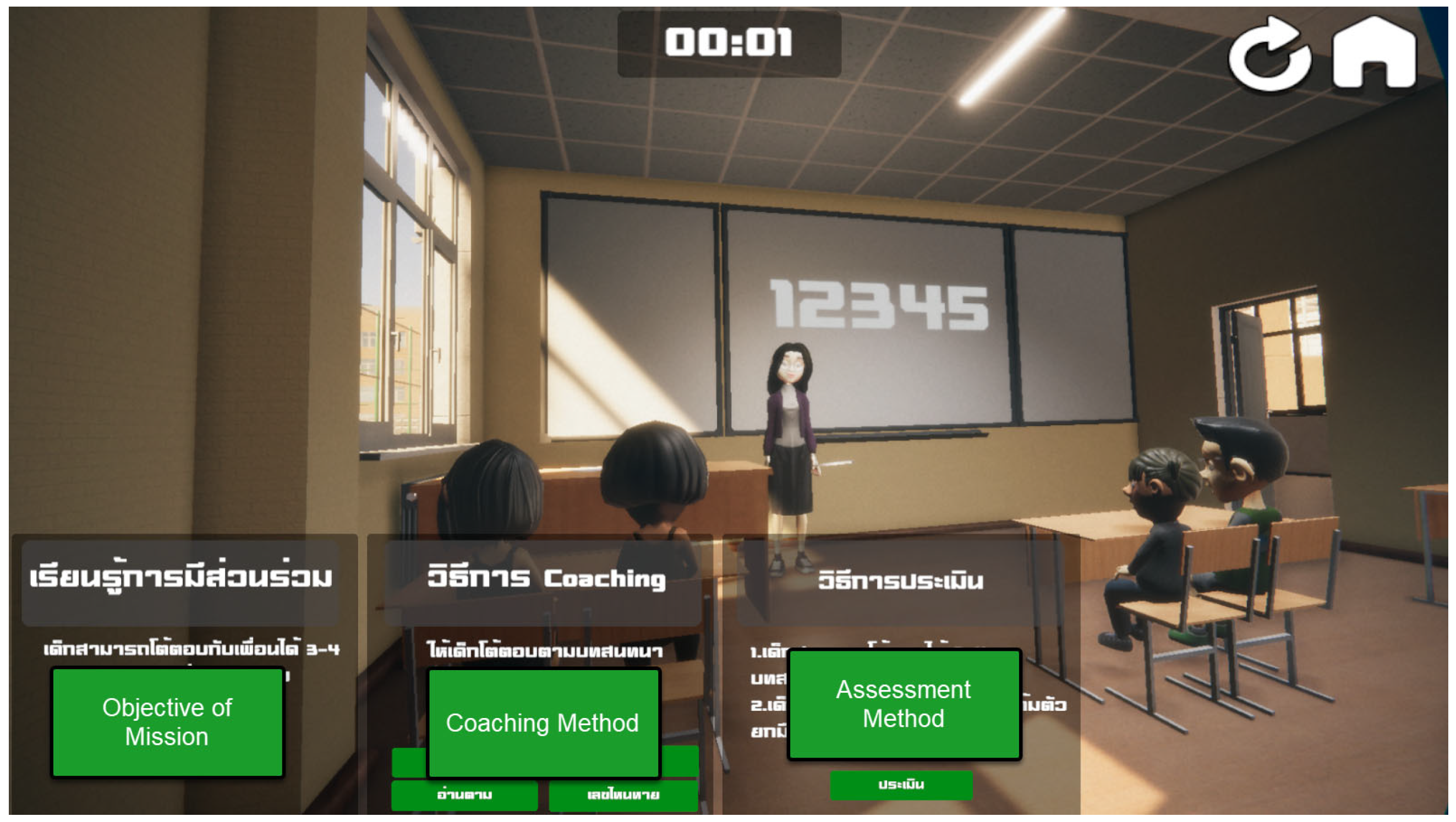

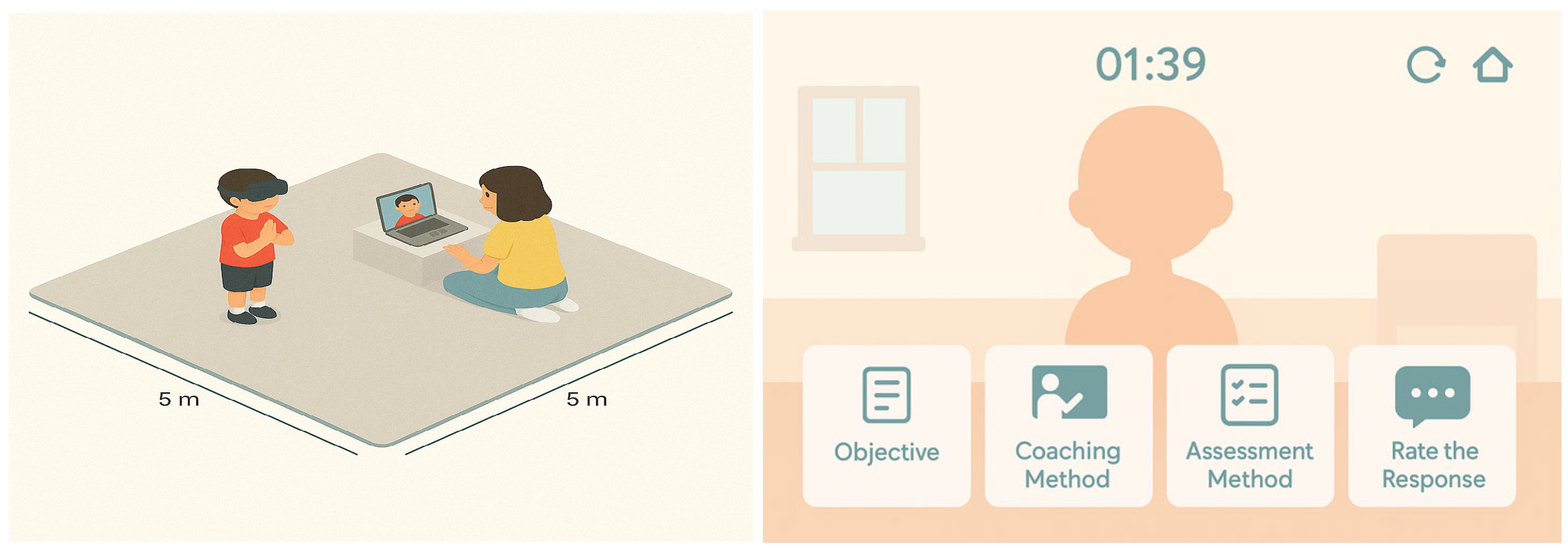
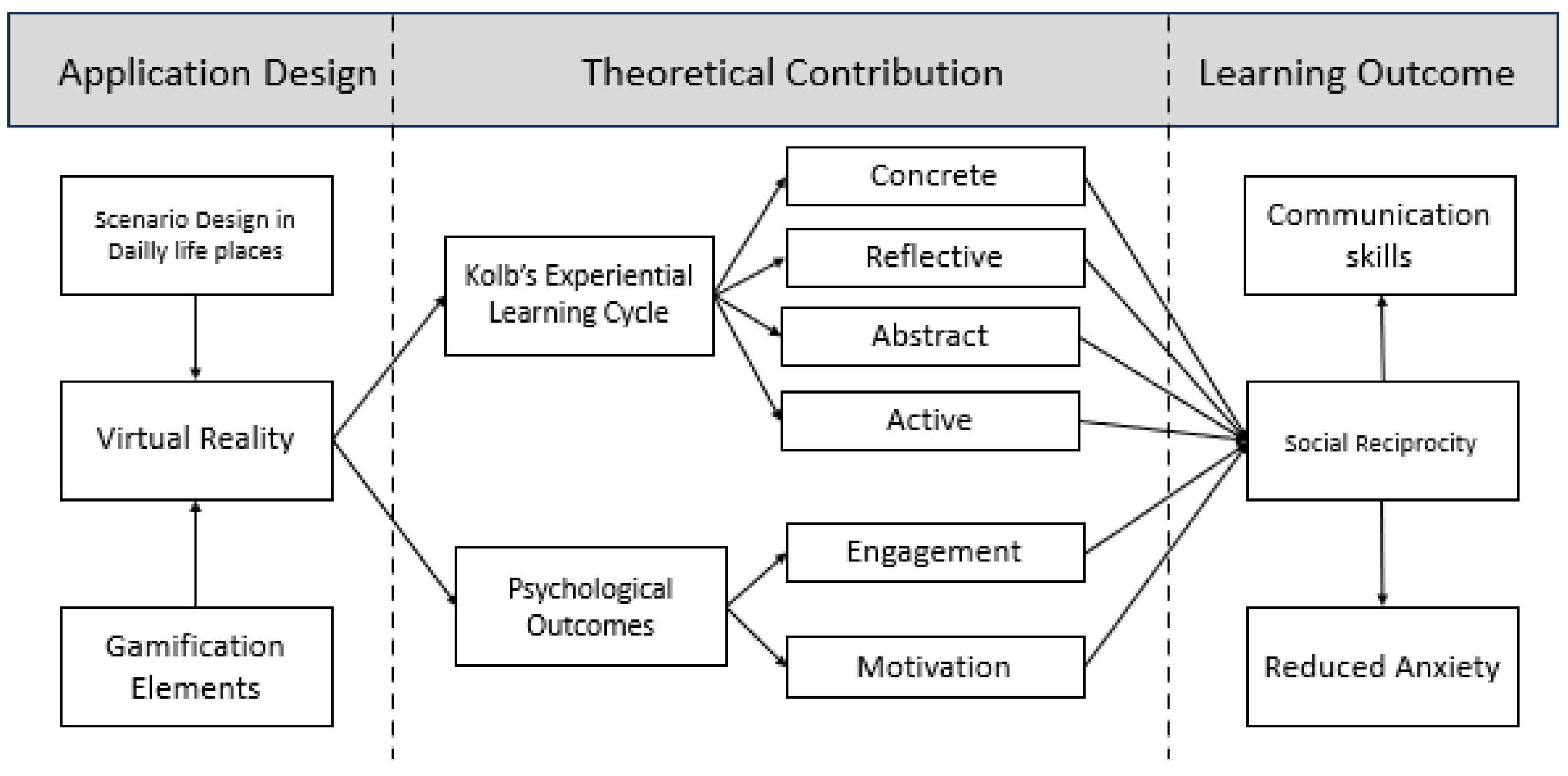
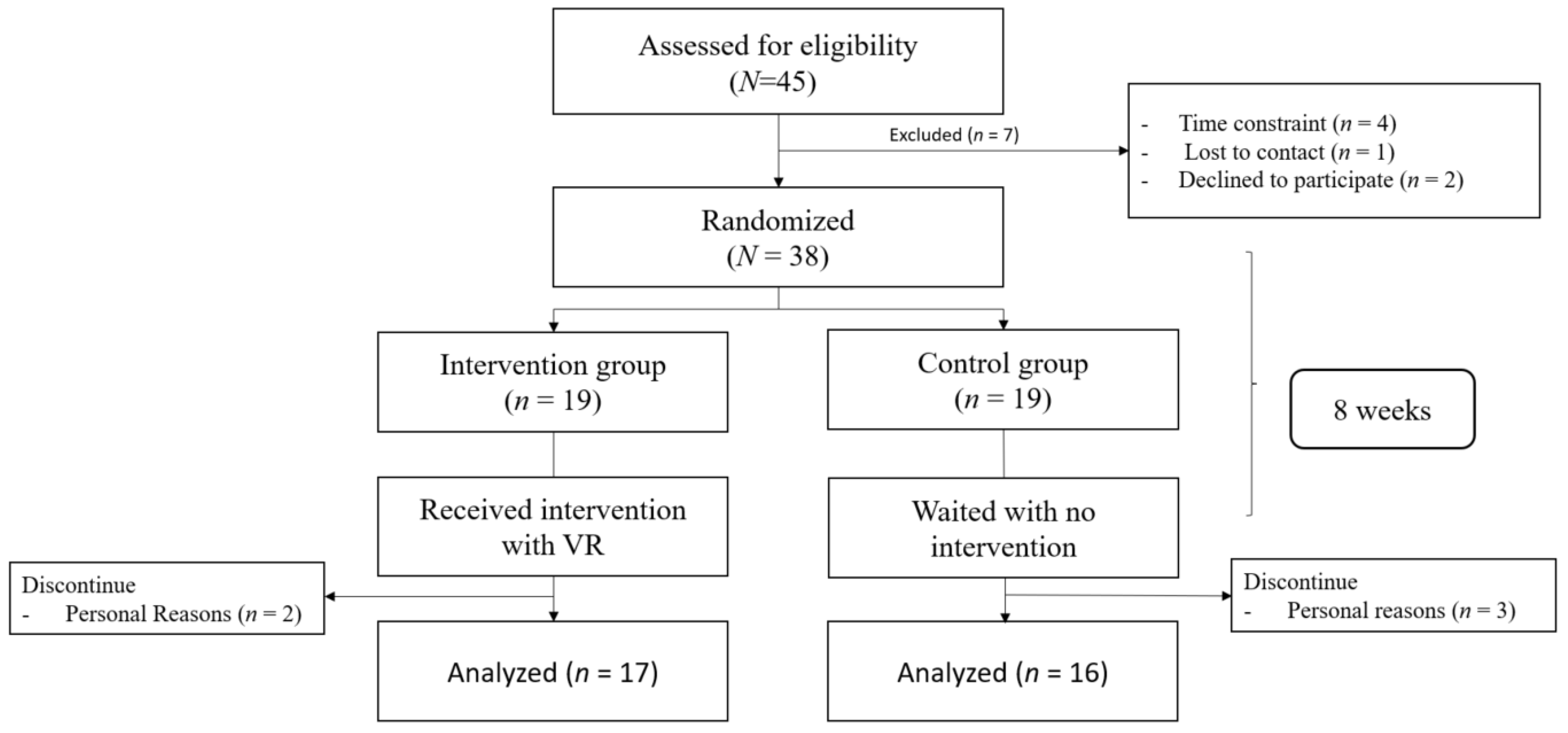
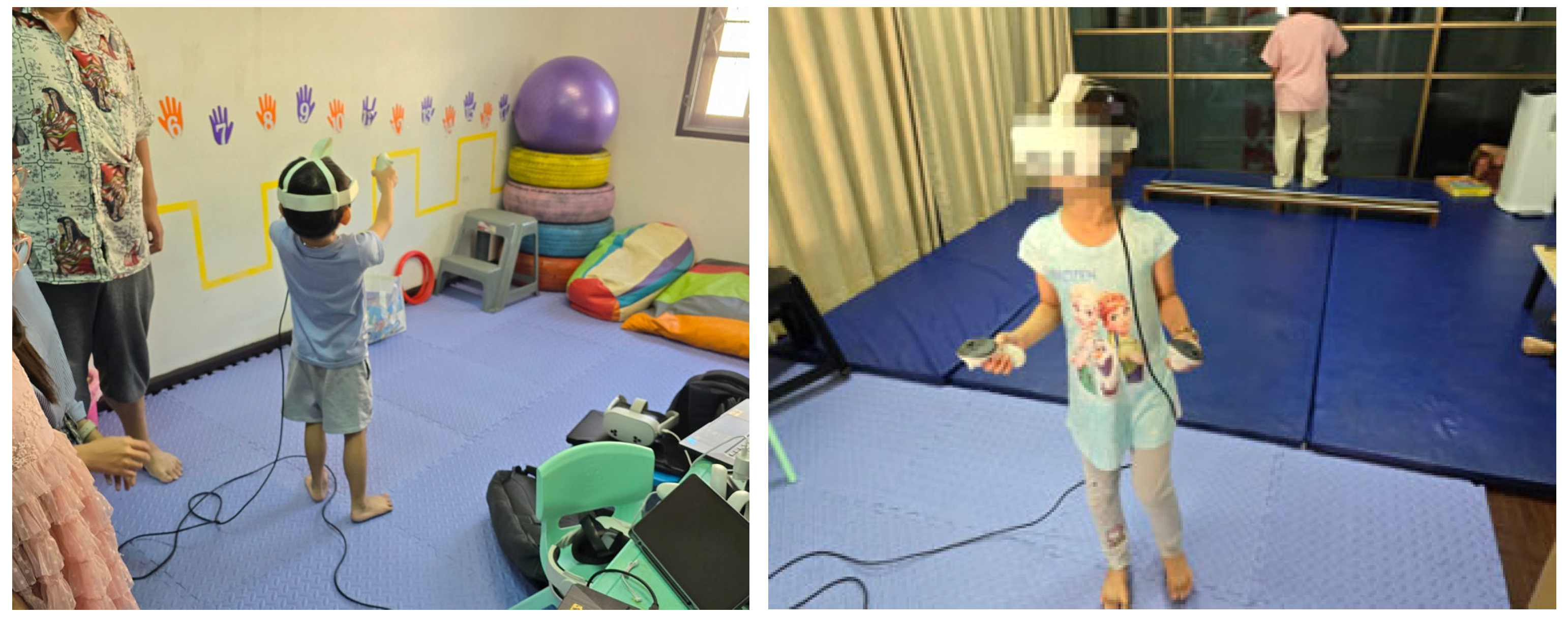
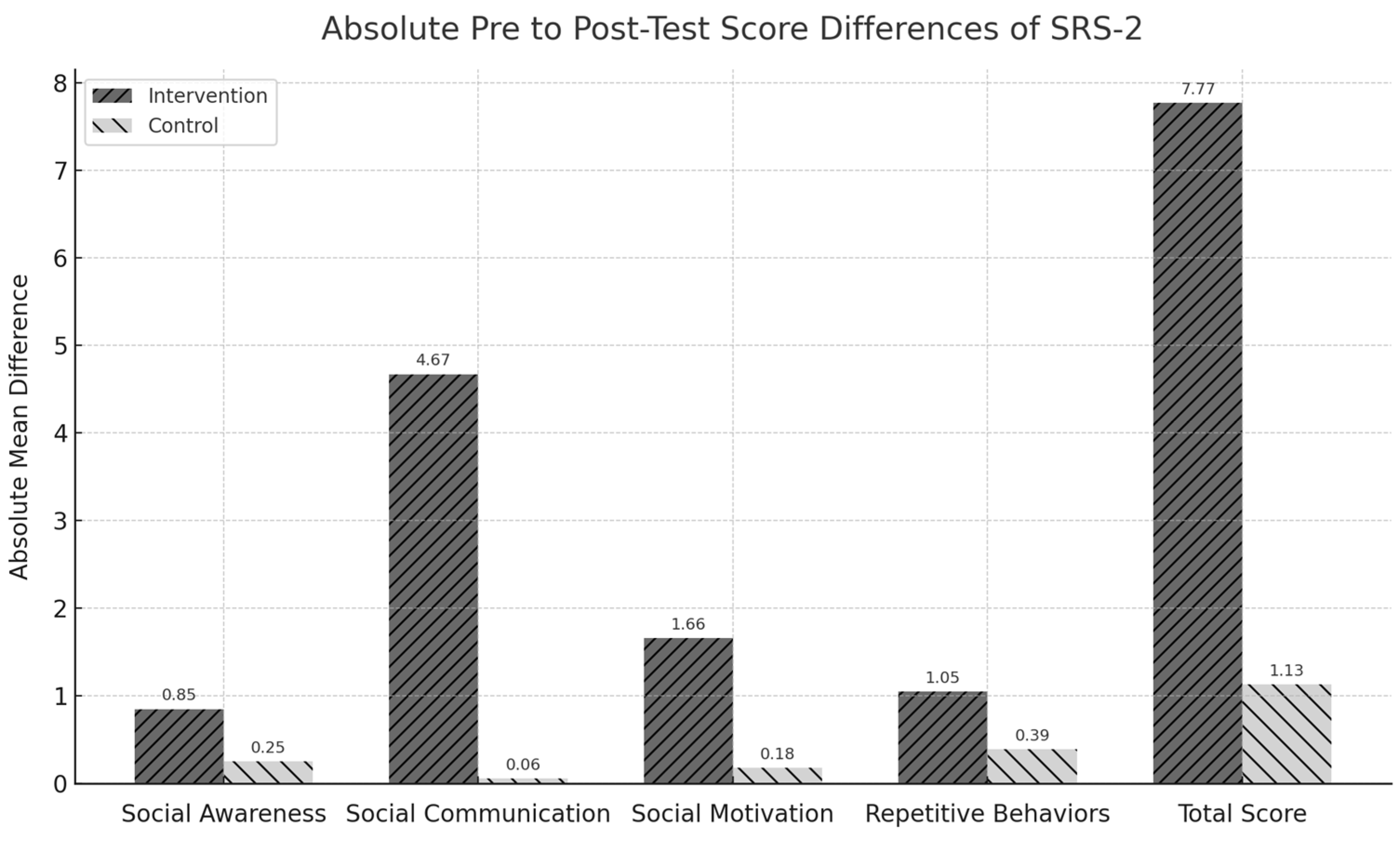
| Platform/Study | Target Skills | Hardware | Country | Findings |
|---|---|---|---|---|
| VR-SS Training (Moon & Ke, 2019) | Social communication, task adherence | Not specific | USA | VR-based social skills training using OpenSimulator showed high treatment integrity across 90 sessions for 15 children with HFA. Treatment integrity (Jaccard Index) varied by scenario: higher in game-based and restaurant-roleplay activities, lower in formal interview settings. |
| VR Rehabilitation Therapy (Zhang et al., 2025) | Cognition, imitation, social interaction | VR HTC VIVE | China | Improved imitation and cognition in ASD children after immersive VR therapy; statistically significant in multiple domains. |
| VRI (Frolli et al., 2022) | Emotion recognition, situational understanding | Not specific | Italy | The VR group showed significantly shorter acquisition times for complex social-emotional tasks, though both groups performed similarly in primary emotion recognition. |
| HSVRS (Yu et al., 2023) | Gaze fixation, attention training | VR + Eye | China | VR-based hide-and-seek significantly improved eye-gaze behavior; supported by attention |
| VRESS (Kourtesis et al., 2023) | Social skills, executive function | HTC Vive Pro Eye | Greece | Performance correlated with executive functioning and memory; adaptive scenarios encouraged participation. |
| (Sideraki & Drigas, 2023) | General social skills | Not specific | Greece | VR is more effective than traditional therapy (e.g., role-play, group sessions) in improving social skills. VR provides a safe, customizable, and immersive environment with higher engagement. |
| VR in Schools (H. H. Ip et al., 2017) | Affective expression, social reciprocity | Oculus Rift | Hong Kong | Large-scale field trial in schools showed affective expression and reciprocity gains using Kolb’s experiential model. |
| VR-based Social Skills Training (Maddalon et al., 2024) | Social communication, emotion recognition | Meta Quest VR | USA | Adaptive VR with biosignal-driven feedback personalized the experience and improved learning outcomes. |
| Learning Module | Scenario | Design | Objective | No. of Sessions |
|---|---|---|---|---|
| 1. Orientation and Familiarization | VR Playground | Safe open area with simple interactive objects for controller practice and avatar exploration. | Learn to navigate, interact with objects, and feel comfortable in the VR environment. | 1 |
| 2. Daily Living Skills | Home Routine | Simulated home with tasks such as brushing teeth, packing a bag, and setting the table. | Learn routines and daily tasks using visual and verbal prompts. | 4 |
| Supermarket | Simulated shopping trip with money handling and grocery choices. | Practice purchasing items, understanding currency, and social interaction with cashiers. | 4 | |
| 3. Affective and Emotional Skills | School Classroom Setting | Children interact with teachers and classmates in a quiet rule-based environment | Learn social norms, self-regulation, and respectful behavior. | 4 |
| Fast Food Restaurant | Ordering food, waiting in line, and responding to staff. | Practice affective expression, waiting turn, and polite responses. | 3 | |
| 4. Social Reciprocity | Crosswalk and Street | Street with traffic lights, vehicles, and pedestrian cues. | Learn road safety, eye contact, and social gestures like waving or thanking. | 4 |
| School Recess | Interacting with peers in a playground setting. | Develop reciprocal communication and shared play behavior. | 4 |
| Dimension | Group | Pre-Test (SD) | Post-Test (SD) | Mean Difference | p-Value | Cohen’s d |
|---|---|---|---|---|---|---|
| Social Awareness | Intervention | 15.82 (3.41) | 14.97 (3.22) | −0.85 | 0.233 | 0.25 |
| Control | 15.67 (3.59) | 15.42 (3.71) | −0.25 | 0.686 | 0.07 | |
| Social Communication | Intervention | 22.14 (4.22) | 17.47 (4.30) | −4.67 | 0.001 ** | 1.11 |
| Control | 21.88 (4.09) | 21.94 (4.01) | +0.06 | 0.939 | 0.01 | |
| Social Motivation | Intervention | 18.76 (3.11) | 17.10 (3.05) | −1.66 | 0.045 * | 0.53 |
| Control | 18.53 (3.08) | 18.71 (3.14) | +0.18 | 0.745 | 0.06 | |
| Repetitive Behaviors | Intervention | 30.63 (5.27) | 29.58 (5.04) | −1.05 | 0.169 | 0.20 |
| Control | 29.87 (5.18) | 29.48 (5.45) | −0.39 | 0.682 | 0.08 | |
| Total Score | Intervention | 87.35 (12.48) | 79.58 (11.92) | −7.77 | 0.020 * | 0.62 |
| Control | 85.94 (11.92) | 84.81 (12.67) | −1.13 | 0.612 | 0.09 |
| Source | Type III Sum of Squares | df | Mean Square | F | Sig. | Partial Eta Squared |
|---|---|---|---|---|---|---|
| Corrected Model | 2019.021 a | 2 | 1009.510 | 30.767 | <0.001 | 0.323 |
| Intercept | 830.106 | 1 | 830.106 | 25.299 | <0.001 | 0.164 |
| pretest | 1933.825 | 1 | 1933.825 | 0.514 | <0.001 | 0.001 |
| Group | 107.265 | 1 | 107.265 | 3.269 | 0.073 | 0.011 |
| Error | 4232.718 | 129 | 32.812 | |||
| Total | 62,046.644 | 132 | ||||
| Corrected Total | 6251.739 | 131 | ||||
| R squared = 0.323 (Adjusted R Squared = 0.312) | ||||||
Disclaimer/Publisher’s Note: The statements, opinions and data contained in all publications are solely those of the individual author(s) and contributor(s) and not of MDPI and/or the editor(s). MDPI and/or the editor(s) disclaim responsibility for any injury to people or property resulting from any ideas, methods, instructions or products referred to in the content. |
© 2025 by the authors. Licensee MDPI, Basel, Switzerland. This article is an open access article distributed under the terms and conditions of the Creative Commons Attribution (CC BY) license (https://creativecommons.org/licenses/by/4.0/).
Share and Cite
Julrode, P.; Worragin, P.; Ariya, P.; Puritat, K.; Intawong, K. Designing Gamified Virtual Reality Intervention Based on Experiential Learning to Enhance Social Reciprocity in Children with Autism Spectrum Disorder. Educ. Sci. 2025, 15, 1104. https://doi.org/10.3390/educsci15091104
Julrode P, Worragin P, Ariya P, Puritat K, Intawong K. Designing Gamified Virtual Reality Intervention Based on Experiential Learning to Enhance Social Reciprocity in Children with Autism Spectrum Disorder. Education Sciences. 2025; 15(9):1104. https://doi.org/10.3390/educsci15091104
Chicago/Turabian StyleJulrode, Phichete, Perasuk Worragin, Pakinee Ariya, Kitti Puritat, and Kannikar Intawong. 2025. "Designing Gamified Virtual Reality Intervention Based on Experiential Learning to Enhance Social Reciprocity in Children with Autism Spectrum Disorder" Education Sciences 15, no. 9: 1104. https://doi.org/10.3390/educsci15091104
APA StyleJulrode, P., Worragin, P., Ariya, P., Puritat, K., & Intawong, K. (2025). Designing Gamified Virtual Reality Intervention Based on Experiential Learning to Enhance Social Reciprocity in Children with Autism Spectrum Disorder. Education Sciences, 15(9), 1104. https://doi.org/10.3390/educsci15091104








